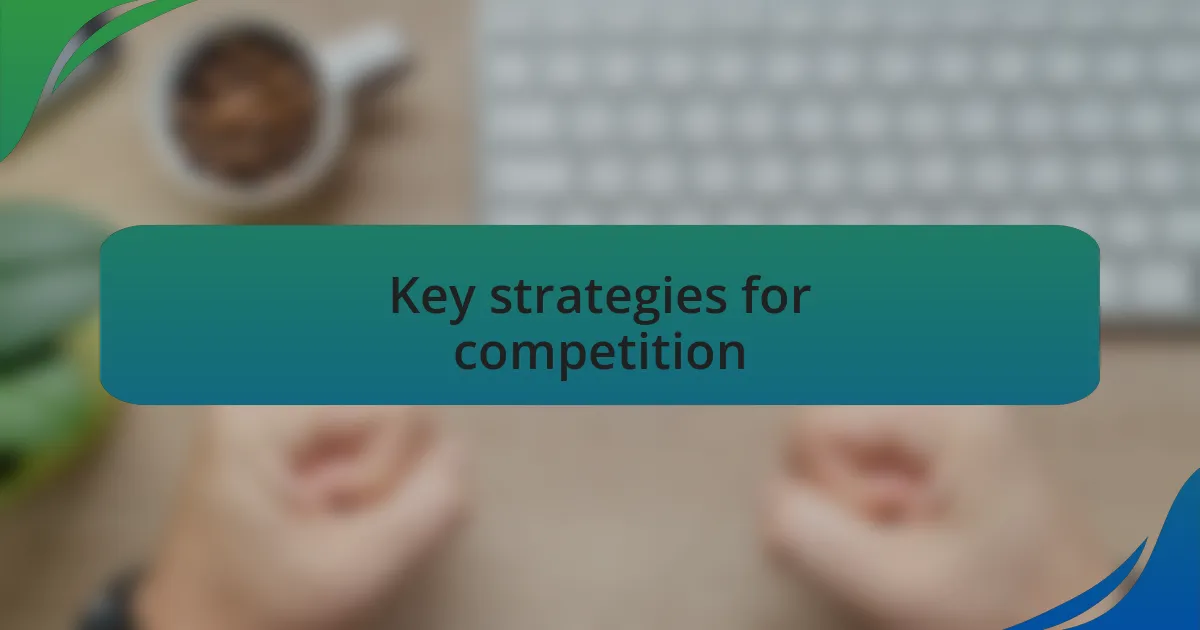Key takeaways:
- Competition drives innovation and encourages businesses to refine their value propositions, turning fear into motivation.
- Collaborating with competitors can lead to shared insights and mutual growth, transforming rivalry into community support.
- Active competition management, including customer feedback and market research, fosters continuous learning and strengthens market positioning.
- Building a unique value proposition through storytelling and aligning with core values can differentiate a business in a crowded market.

Understanding competition in SME development
Competition in SME development is both a challenge and an opportunity. From my experience, it often feels like standing at the foot of a mountain. You see competitors scaling the heights, and it’s easy to feel intimidated. But isn’t that pressure what drives innovation? Recognizing competition as a catalyst can shift your mindset from fear to motivation.
I remember when my small business faced a formidable rival. Their aggressive marketing caught me off guard, leaving me questioning my own strategies. It forced me to take a hard look at my value proposition. Was I truly understanding my customers’ needs? Competition pushed me to refine my offerings, and in that moment, I discovered the importance of differentiating my brand—I learned that knowing your unique strengths can set you apart.
Understanding competition also means embracing collaboration. Sometimes, it may seem counterintuitive, but I’ve found that creating partnerships with other SMEs can lead to shared insights that strengthen everyone involved. Have you ever considered that your competitors might actually be your allies? Pooling resources and knowledge can forge a path to mutual growth, transforming the competitive landscape into a community of shared success.

Importance of competition management
When I reflect on the importance of competition management, one truth stands out: knowing your competitors can illuminate paths for growth. In my early days as an entrepreneur, I spent hours analyzing the strategies of businesses I admired. This exercise not only highlighted gaps in my own approach but also inspired me to innovate. Isn’t it fascinating how a competitor’s success can become the fuel for your own improvements?
Effective competition management is also about protecting your market position. I recall a moment when a competitor launched a similar product to mine at a lower price. Instead of panicking, I looked critically at my offering and focused on enhancing the quality and customer experience. It became clear that competition helps in solidifying one’s brand identity. Wouldn’t you agree that navigating such challenges can elevate both your business and your confidence?
Moreover, actively managing competition fosters a mindset of continuous learning. I’ve learned that engaging with competitors at industry events often leads to unexpected discussions—sharing insights that push us all toward best practices. This perspective can create a healthier competitive environment, where everyone contributes to raising the bar. Can you see how cultivating a strong understanding of your rivals turns competition into an opportunity for collective growth?

Key strategies for competition
One key strategy for managing competition is to differentiate your offerings. I vividly remember when I launched a service that had to compete with a well-established player in my market. Instead of trying to beat them on price, I focused on creating a unique feature that specifically addressed a customer pain point. This not only attracted attention but also helped build a loyal customer base that valued my innovative approach. Have you considered what makes your product or service stand out in a crowded market?
Another effective approach is to actively seek customer feedback and adapt your strategy accordingly. In a recent project, I implemented a feedback loop with my customers, allowing them to voice their desires and concerns. This direct line of communication led to significant improvements and made me realize that my customers could guide my competitive edge. Isn’t it incredible how listening can lead to a stronger position in the marketplace?
Finally, leveraging partnerships can elevate your competitive strategy. Early in my journey, I collaborated with another small business whose strengths complemented mine. This partnership not only expanded our reach but also enriched our offerings, showcasing how collaboration can enhance competitiveness. Have you thought about how alliances could benefit your business and create a more formidable presence against rivals?

Building a unique value proposition
When building a unique value proposition, it’s essential to identify what truly makes your offering special. In my own experience, during the launch of a product that seemed similar to many others in the market, I realized I needed to focus on storytelling. I shared the journey behind my product and connected emotionally with customers, highlighting not just what it was, but why it mattered. Have you ever thought about the power of a story in setting you apart?
I remember one occasion when a competitor introduced a new feature that garnered a lot of attention, leaving me feeling a bit disheartened. Instead of mimicking their approach, I took a step back and reassessed my value proposition. I honed in on the personal connections I fostered with my clients, emphasizing my commitment to customer service. This pivot reinforced my brand identity and reinforced customer loyalty. It’s intriguing how sometimes, going deeper rather than wider can redefine our unique strengths.
Another angle worth exploring is the way we frame our uniqueness. Just last year, I revamped my marketing materials to showcase not only my products but also the values my business stands for—sustainability, community, and integrity. This approach resonated with my audience, proving that a clear and compelling value proposition can attract an audience that aligns with your vision. Have you considered how your core values can redefine your market position?

Leveraging market research for insights
Understanding the market landscape through research can be a game-changer. There was a time when I underestimated the value of customer surveys and feedback; however, once I embraced them, I uncovered insights that directly informed my product development. Have you ever had an “aha!” moment when your customers revealed exactly what they wanted?
I distinctly recall a scenario where I gathered data on customer preferences and discovered a surprising trend—buyers were eager for eco-friendly alternatives. By pivoting my strategy to incorporate sustainable materials, I not only captured a new audience but also revitalized my brand’s relevance. It’s fascinating how simple insights from market research can reshape your entire direction.
Additionally, competitor analysis illuminated opportunities I never considered. I learned to monitor not just their strengths but also their weaknesses. This dual approach helped me position my offerings in a way that appealed directly to the gaps in the market. What if your next big breakthrough is just a competitor’s oversight waiting to be capitalized on?

Developing partnerships and collaborations
When I started collaborating with local businesses, I quickly realized the immense potential of partnerships. For instance, a small café and I teamed up for a community event, and the results were beyond what we anticipated. By pooling our resources, we not only increased foot traffic but also fostered a sense of community engagement that neither of us could have achieved alone. Have you thought about how collaborating might amplify your reach?
One memorable partnership involved joining forces with a nonprofit organization focused on sustainability. This collaboration allowed me to contribute to something meaningful while also increasing brand visibility in a way that felt authentic. It was heartwarming to witness how the mutual support lifted both our missions. I often wonder, how many opportunities exist right in front of us, waiting for a partnership to bring them to life?
As I’ve navigated the competitive landscape, I’ve come to understand that collaboration is key to overcoming challenges. By sharing expertise and resources, I found solutions to problems that individually seemed insurmountable. When was the last time you considered that your competition could actually become a partner for growth?

Personal experiences in managing competition
Managing competition has often felt like walking a tightrope for me. I vividly recall one year when a new competitor opened nearby. Instead of seeing them as a threat, I chose to engage with them. We had a candid conversation about our businesses, which led to outwardly supporting each other’s events. This not only diminished the feeling of rivalry but also enriched our customer bases. Have you ever thought about turning competition into camaraderie?
Another defining moment in my journey was during a slow season when competition was particularly fierce. I organized a customer feedback session, inviting loyal patrons to share their thoughts. This experience not only provided invaluable insights but also fostered a loyal community. Listening to their suggestions, I could refine my offerings, which directly contributed to standing out amidst the competition. Isn’t it amazing how turning to your customers can lead to breakthroughs?
I’ve learned that a strong focus on customer service can be my greatest competitive advantage. I remember one instance when a customer chose to share their frustration with me rather than switching to a competitor. By addressing their concerns personally and promptly, I not only retained their loyalty but transformed them into a vocal advocate for my business. How often do we overlook the simple power of connection in a competition-driven environment?